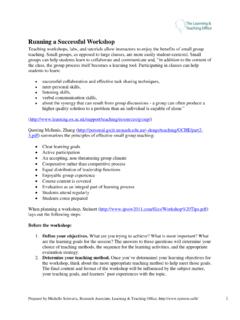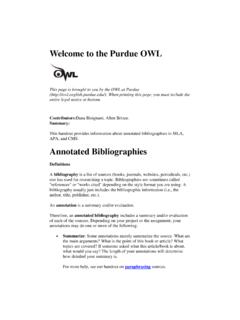Transcription of Best Practices - Ryerson University
1 Best PracticesAlternativeAssessmentsA good post-secondary education facilitates numerous kinds of learning that includes acquiring factual knowledge, professional skills, and skills of application, such as critical reflection, problem solving, writing, conceptualizing, collaboration, creativity, civic and global learning, and reasoning. In order for an assessment, usually in the form of an assignment or a test, to be valid, it should measure the skills or knowledge that you have planned for your students to learn.
2 However, many University courses still rely heavily on a narrow range of assessment tools that typically ask students to memorize large amounts of content without needing to apply it (Queen s University Centre for Teaching and Learning, ).Besides providing important information to the instructor about the nature of student progress in terms of breadth and depth of learning (Queen s University Centre for Teaching and Learning, ), assessments can guide the way that students choose to learn. Biggs argues that what and how students learn depends on how they think they will be assessed (1999, p.)
3 141). This means that in most cases, students will only focus on learning the skills that will permit them to do well in the class. If the only forms of assessment tools used in the class are tests or exams, the student will memorize the factual information that they need to know in order to get a good grade, forgetting much of the factual information a week later (Mazur, 2015). In this issue of Best Practices we will review ways that alternative assessments, also known as authentic assessments, can be used to improve student or Authentic AssessmentsThe traditional form of assessment in the post-secondary course is a mid-term or final or exam.
4 This type of assessment often fails to assess deeper forms of learning. Carefully designed assessments, on the other hand, not only evaluate what students have learned, but can motivate students in their approach to learning, helping them develop thinking and problem-solving skills, and allowing them to assess their own understanding of the course content (Ibid). This is where alternative assessment or authentic assessment, comes in. Authentic or alternative assessments, meaning an alternative to standard tests and exams, provide a true evaluation of what the student has learned, going beyond acquired knowledge to focus on what the student has actually learned by looking at their application of this knowledge (Indiana University , ).
5 Alternative forms of assessment can allow you to see what student can and cannot do, versus what they do and do not know. They tend to evaluate applied proficiency rather than measuring knowledge (Brigham Young University , ), allowing for problem solving and reflection, rather than merely providing facts as answers to specific questions (Indiana University , ). Authentic or alternative assignments typically require students to make a judgement about what information and skills they will need to solve a given problem.
6 They ask students to answer essential questions in the discipline by using knowledge in similar ways to professionals in the field. They can often be characterized as real-world situations with accompanying real-world constraints. Alternative or authentic assignments should involve written and performative measures so that students can develop meaningful and applicable skills, and advance their knowledge of the how over that of the what Best Practices in Alternative Assessments(Ibid). These types of assignments are also meant to help develop disciplinary behaviors in students, making new connections between existing skills Traditional Assessment versus Alternative AssessmentTraditional AssessmentAlternative AssessmentWhat Makes it AuthenticRequires right answerRequires high-quality performance or product.
7 Along with justifications of must be able to think through why they made decisions that resulted in final must be unknown to students in advanceInstructions/questions/purpose must be known to students in that are to be judged should be known ahead of time. Rubrics should be from the real worldTied to real-world contexts and constraints. Requires student to solve realistic is similar in nature as to what would be encountered by a real-life of skills, focus on factsA range of skills/knowledge need to be integrated in order to solve a are multi-step and scoredIncludes complex tasks for which there may not be a right assessment and feed-back is emphasized.
8 One shot approachIterative in and skills are used in more than one a scoreOpportunity to provide diagnostic to give practical experi-ence and improve future from Indiana University s Tip Sheet, Authentic Assessment, Alternative AssignmentsBrigham Young University has created a great set of guidelines for constructing alternative assignments: Define a concrete and unambiguous instructional outcome/goal that you want to assess. Make sure that you include both subject-matter content and a set of skills/operations that a successful student would exhibit.
9 Define what can be assessed through performance assessment, and what can be assessed through objective performance measures. Create tasks/assignments that elicit this behavior. Decide what kind of guidance you can provide while still allowing students to learn independently. Try the assessment out and make revisions as are some additional useful questions to ask yourself, when you are deciding on what assessment to choose: Do you want to test acquisition of content knowledge, or the ability to apply that knowledge?
10 Do you want to assess a product that a student has produced, or the process by which they produced it? Do you want to assess any of the following: writing ability, speaking skills, creativity, use of technolo-gy, or collaboration? Are specific time constraints important? What kind of content knowledge should students be able to demonstrate and at what level? What higher order thinking skills do you want students to develop and be able to demonstrate? Which assessment methods would allow you to understand how well students are achieving learning outcomes?














